Drata may be big, but it's not always the best fit. Many SaaS founders realise this after their first demo, or worse, after signing a one-year contract.
In fact, 4 out of 10 teams exploring SOC 2 end up looking for Drata competitors within weeks. Most cite price jumps, hidden costs, or confusing setups as deal-breakers.
If you're searching for the best Drata alternatives, this guide will walk you through how learner teams like yours can still close enterprise deals, with fewer clicks and way less spend.
You'll also meet platforms that get you compliant in just a few days. ComplyJet is one of them. It's a fast-growing Drata alternative built for startups that move fast and don't want to wait.
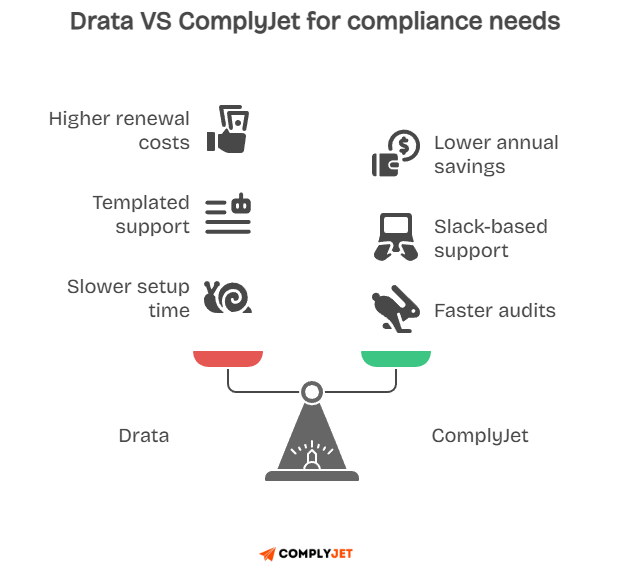
Drata's no longer the default choice, and we'll unpack what Drata actually is and why some teams still go with it.
What is Drata?
Drata is a compliance automation tool. It helps companies achieve and maintain certification under frameworks such as SOC 2, ISO 27001, HIPAA, and GDPR.

It integrates with your systems, such as AWS, GitHub, and Google Workspace, and monitors them for security controls. It also automatically collects evidence for auditors and displays your compliance status in one place.
The platform leans heavily on automation. That's a significant advantage for mature SaaS teams that already have established controls and security policies in place. But it assumes you already know what you're doing.
You'll also find workflows for onboarding auditors and managing tasks across compliance teams. These work well at scale, but can be overwhelming if you're still figuring out the basics.

If you're a mid-sized SaaS with an internal security hire, Drata works fine. But for a lean startup trying to move fast, you may want a platform like ComplyJet that doesn't slow you down.
To learn more, read: Drata Review 2025: Features, User Reviews, Pros & cons.
Now, let's talk about why teams go looking for a Drata alternative in the first place.
How is Drata Different from Competitors?
Drata was built with scale in mind. It is best suited for larger SaaS companies that already have mature systems in place. If your team operates like a mini-enterprise, it feels familiar quickly.
Most of its strength lies in automation. Once you connect your cloud stack, Drata monitors your security controls and keeps your audit prep moving in the background.
Drata's engine handles 75% to 85% of audit work for you. That includes evidence gathering, control testing, and status tracking. It's backed by 300+ integrations with tools like AWS, GitHub, and Okta.
For companies with 200 or more employees and a dedicated compliance function, this automation scales effectively. You can map frameworks like SOC 2 and ISO 27001 without manually reviewing every control.
But when you're a 15-person team racing toward your first SOC 2 report, Drata feels bulky. Setup can take weeks. Pricing is locked behind sales calls. Add-ons come later, and the final cost adds up fast.
Read: Drata Pricing Plans 2025: Real Cost, Hidden Add-ons & ROI Analysis
If you care more about closing your next deal than customising a dashboard, you'll likely want a simpler tool. The next section explains why many teams eventually move away from Drata.
Why Companies Look for Drata Alternatives?
At some point, you'll start asking questions. Is Drata worth the price? Could we get the same results with fewer clicks and fewer invoices?
It usually begins after year one. Many teams report a 30% to 40% increase in renewals. Add-ons, such as ISO 27001 or HIPAA, are available at separate pricing. You may also pay an additional fee for questionnaire automation or Trust Centre access.
The platform also slows down small teams. First-time setup takes 3–6 weeks. And support often feels templated. If you need quick, practical answers, it's hard to move fast inside Drata's ecosystem.
Drata's competitors, such as ComplyJet, take a different approach. They provide Slack-based support, one-on-one compliance assistance, and ready-to-use templates. It's more hands-on, which means faster audits and less internal guessing.
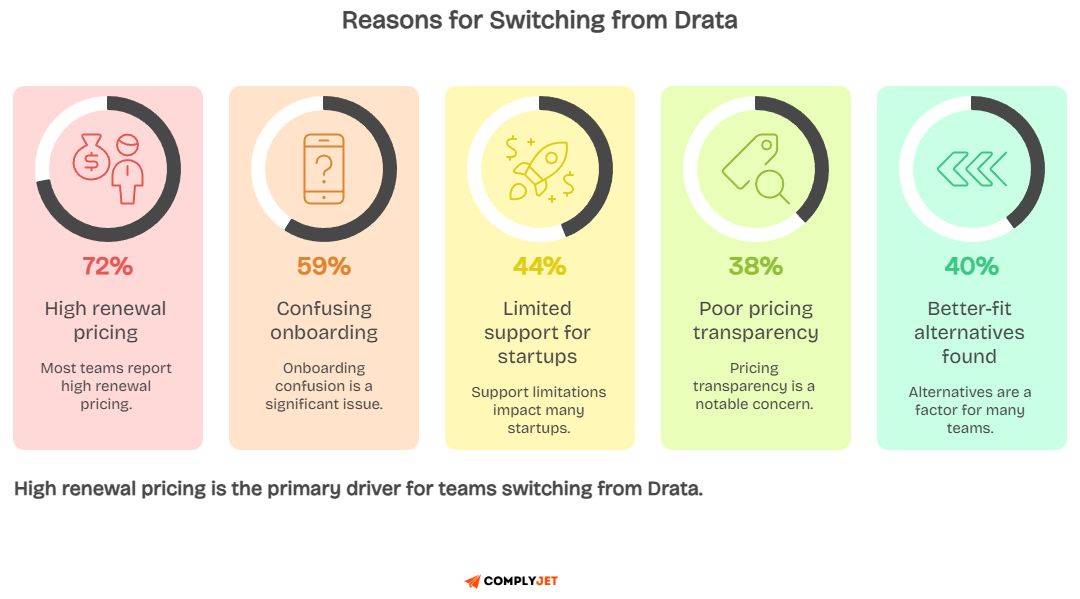
This is especially useful if you're in the healthcare technology industry, where HIPAA compliance is a top priority. Or if you're chasing your first SOC 2 and don't want a slow onboarding cycle holding up sales.
Startups switching to ComplyJet save $10K or more every year on average. That's a budget you can reinvest in product or sales instead of tools that slow you down.
Next, we'll delve into the top Drata alternatives and explore what sets them apart, including features, pricing, and performance.
Top 8 Drata Alternatives & Competitors in 2025
Each platform below is a Drata competitor used by real teams that value speed, price clarity, and better support. You'll see who it's built for, what it does well, and when it beats Drata.
Let's break this down platform by platform. I've included features, pricing, pros, and watch-outs. These tools may all promise compliance, but they don't work the same way.
1. ComplyJet
ComplyJet is designed for startups that want to achieve SOC 2, ISO 27001, or HIPAA compliance without friction. It's fast, simple, and doesn't bury you in dashboards. Teams go live in under a week.
You get AI-driven controls, policy drafts, and direct access to compliance experts on Slack. The platform is lean, but includes everything most B2B SaaS teams need to get audit-ready fast.
Key Features:
- SOC 2, ISO 27001, HIPAA, GDPR, PCI support
- AI Policy Wizard for fast setup
- 100+ integrations with cloud and code tools
- Public Trust Centre for customer reviews
- Flat pricing with no per-user or framework fees
ComplyJet Pricing Starts at $4,999/year for 1 framework, $7,999 for 3 frameworks, with discounts on 3-year terms
Pros:
- Fastest SOC 2 readiness (7 days average)
- Most transparent pricing in the category
- Real-time Slack access to compliance experts
- Free trial available
- Tailored for early-stage SaaS
Cons:
- Small number of integrations compared to Drata
- Lacks advanced analytics for large enterprises
Best for: Startups with 100 employees or fewer, especially those in healthcare, dev tools, or B2B SaaS, selling to enterprise buyers. Faster than Drata by 3–4 weeks on average, and 50% lower annual cost.
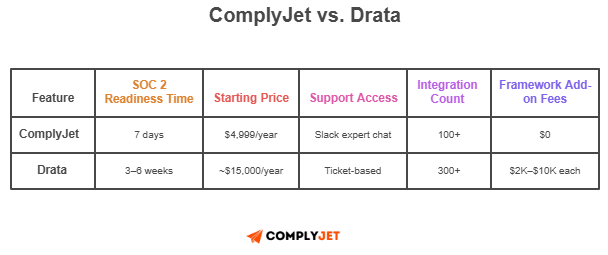
2. Sprinto
Sprinto offers the widest framework coverage in the market. It's built for fast-growing companies with some compliance knowledge, providing both platform automation and expert support.
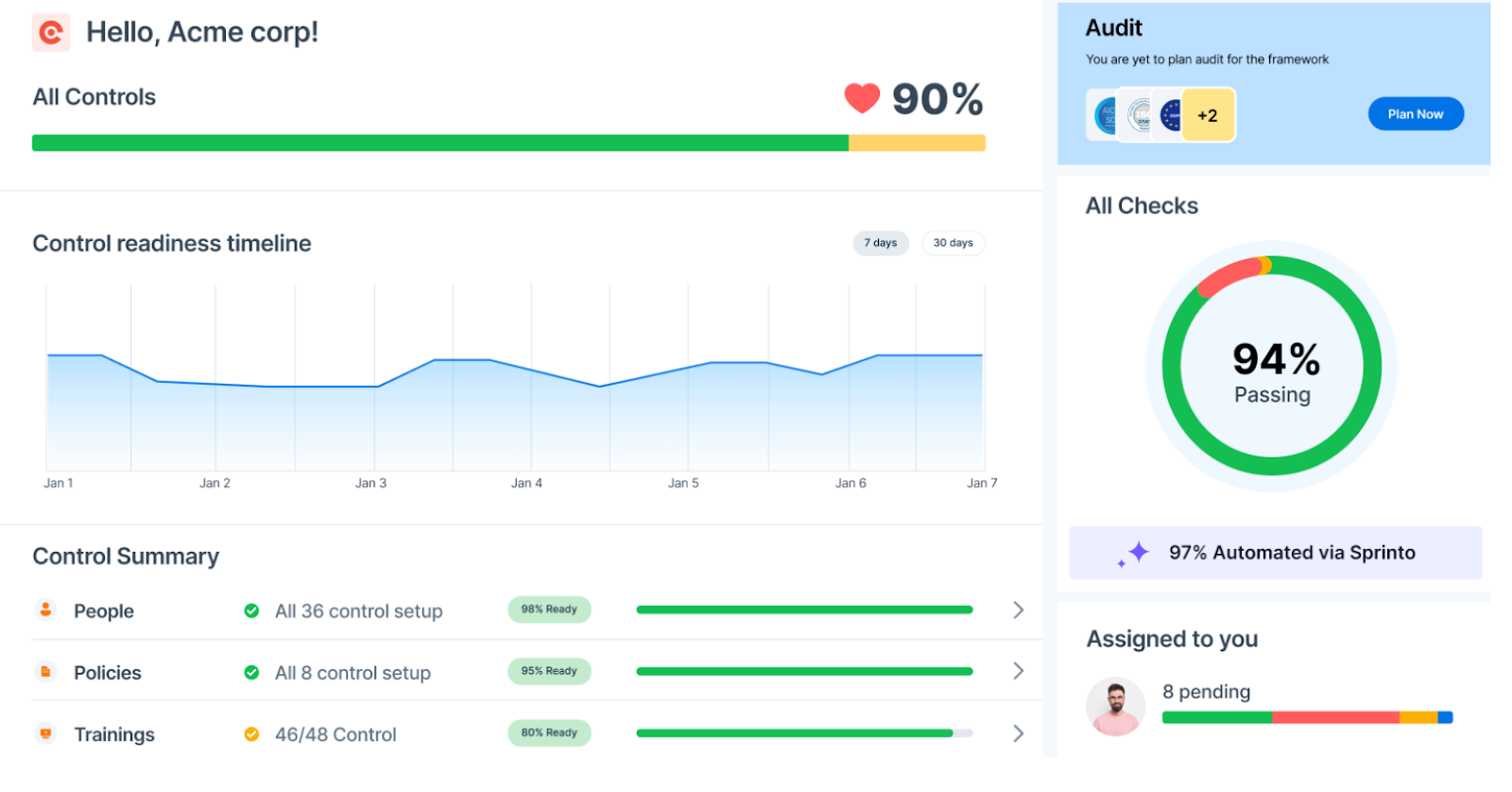
Unlike Drata, you get help from a compliance specialist from day one. Every customer gets a dedicated success lead, which makes onboarding less risky.
Key Features:
- 200+ frameworks, including SOC 2, ISO, HIPAA, NIST, and FedRAMP
- Continuous monitoring and evidence tracking
- 200+ integrations with tools like AWS, GitHub, Jira
- Audit-ready templates and async audit workflows
- Dedicated compliance manager included
Sprinto pricing starts around $7,500/year for the core plan. Add $2,000 for each extra framework. Typical spend is estimated to be $9,000–$20,000/year.
Pros:
- Massive framework library
- Strong onboarding support
- Control reuse across frameworks
- Expert-led implementation
- 100% async audit support
Cons:
- Final pricing requires a sales call
- May feel overbuilt for teams under 20
- Custom workflows take time to configure
Best For: SMBs scaling from 50 to 200 employees who want support with fast growth and complex setups.
Read: Sprinto Review 2025: Features, User Reviews, Pros & cons.
3. Vanta
Vanta is the biggest name in the space. Thousands of mid-size and enterprise SaaS companies use it. The platform runs 1,200+ hourly tests and connects to nearly every tool in your stack.

However, most teams encounter costs that accumulate quickly. Vendor risk reviews, questionnaire automation, and support all incur additional costs.
Key Features:
- 35+ frameworks, including SOC 2, ISO, PCI, and HIPAA
- 375+ integrations
- AI-powered security questionnaires
- Public Trust Centre for customer assurance
- Continuous compliance monitoring
Vanta pricing starts around $10,000/year. Most teams pay $19,000–$30,000+ depending on use and add-ons
Pros:
- Best integration coverage
- Strong automation performance (90%+)
- Solid brand recognition with auditors
- Public Trust Centre is well-designed
- AI handles 80% of questionnaires
Cons:
- 30–40% renewal price increases
- Add-ons like questionnaire AI cost $10K–$25K
- Learning curve is steep for small teams
Best For: Mid-market companies with complex stacks and budgets over $20K/year. Drata's closest peer in terms of features, but often more expensive, with even more hidden pricing.
Read: Vanta VS Drata: Which Compliance Tool is Right for You in 2025?
4. Secureframe
Secureframe focuses on automation for cloud security evidence. It automatically pulls configurations from your infrastructure and helps teams stay prepared throughout the year. It's great for dev-heavy teams who hate screenshots.
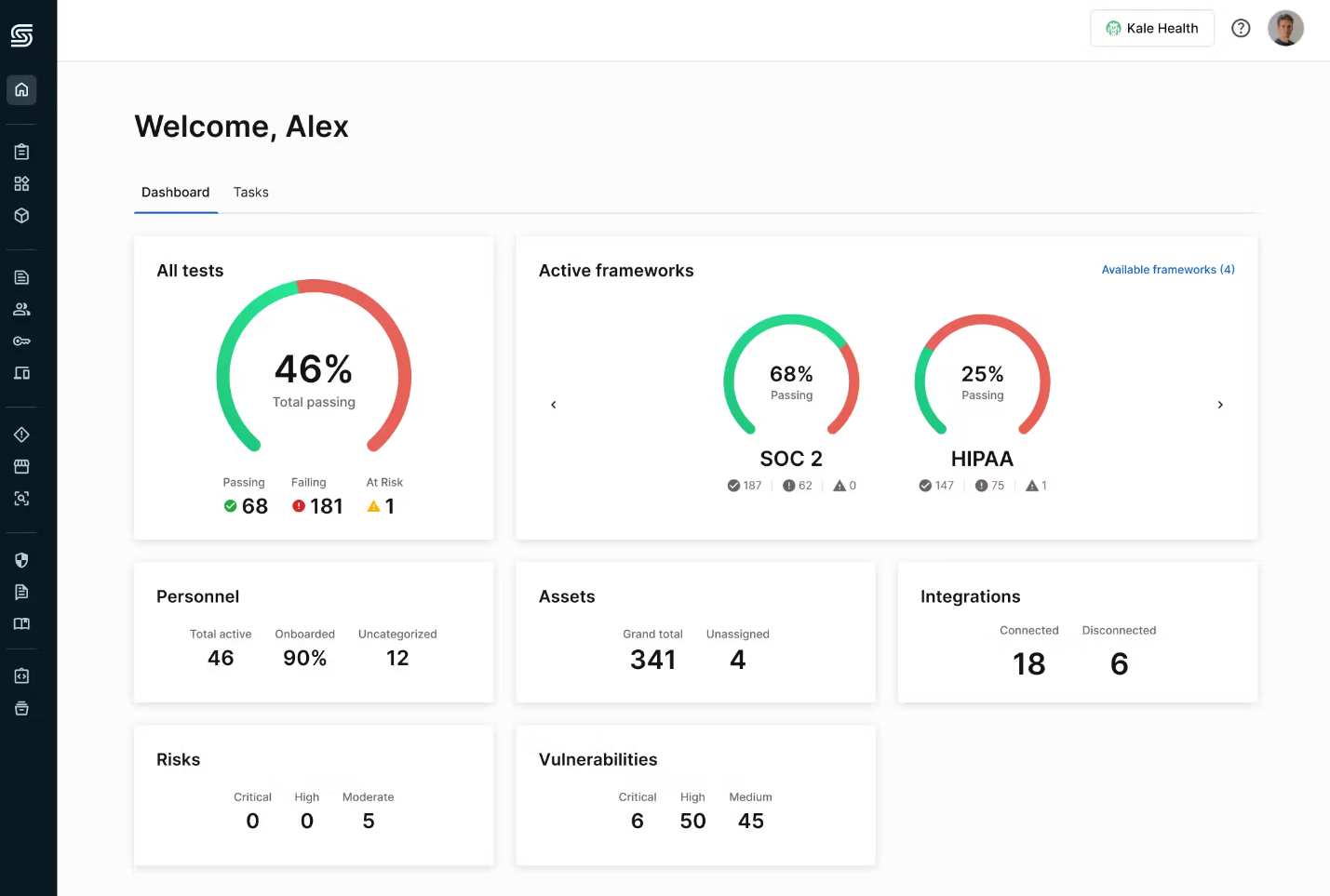
Setup is smooth, but pricing increases rapidly with each additional framework.
Key Features:
- Evidence automation from AWS, GCP, Azure, and Okta
- Prebuilt policy libraries
- 300+ integrations
- AI for questionnaire responses
- Real-time compliance dashboard
Secureframe pricing starts around $7,500 for the base plan. Typical total: $15,000–$45,000 with add-ons and framework upgrades
Pros:
- Less manual evidence work
- Good AI for customer security reviews
- Clean policy templates
- Public-facing Trust Centre
Cons:
- Pricing jumps quickly
- Add-ons are required for serious features
- Lacks detailed support for small teams
Best For: Cloud-native SaaS with full-time engineers and budgets around $20K. More automated than Drata on cloud evidence, but still pricey for early-stage teams.
Read: Secureframe Reviews 2025: Pricing, Features, Feedback, FAQs
5. Thoropass
Thoropass handles multi-framework programs across business units. It's strong on niche standards like HITRUST, and helps you track shared controls across teams.

If you run multiple entities or sell into regulated industries, tracking becomes smoother.
Key Features:
- 30+ frameworks
- Shared controls across workspaces
- Access reviews and risk registers
- First-pass audit AI
- In-platform auditor ecosystem
Thoropass pricing starts around $8,700/year. Most teams spend $ 30,000 or more for full coverage.
Pros:
- Built for multi-framework use
- Saves time with control reuse
- Includes audit coordination
- Works well with enterprise auditors
Cons:
- Setup takes 4–6 weeks
- Custom integration work needed
- Advisory-heavy for smaller teams
Best For: Mid-sized SaaS with complex compliance plans or niche frameworks. Cheaper than Drata in some cases, but built more for internal compliance teams than founders.
6. OneLeet
OneLeet blends service and software. Their model assigns a security engineer to guide your setup, manage remediation, and even handle communication with auditors for you.

This is ideal if you want someone to "do it for you" without hiring a security lead.
Key Features:
- SOC 2, ISO, HIPAA support
- Built-in pentesting from OSCE-certified engineers
- Control mapping and policy drafting by experts
- No-code workflows
- Slack-based communication
Oneleet offers custom pricing only. It typically ranges from $15,000 to $ 50,000 per year, depending on the services provided.
Pros:
- Done-for-you setup
- Experts manage everything
- Penetration tests included
- Ideal for non-technical founders
Cons:
- Zero pricing transparency
- Slower scaling to more frameworks
- Less dashboard-level control
Best For: Early-stage teams without internal compliance or security headcount. If Drata feels like DIY, OneLeet does it all for you, but at a premium price.
Read: OneLeet vs Delve: SOC 2 Pricing, Features, Reviews [2025]
7. AuditBoard
AuditBoard is a GRC platform for enterprises. It covers audit, risk, ESG, and SOX. It's trusted by public companies and global brands that need full visibility across large teams.
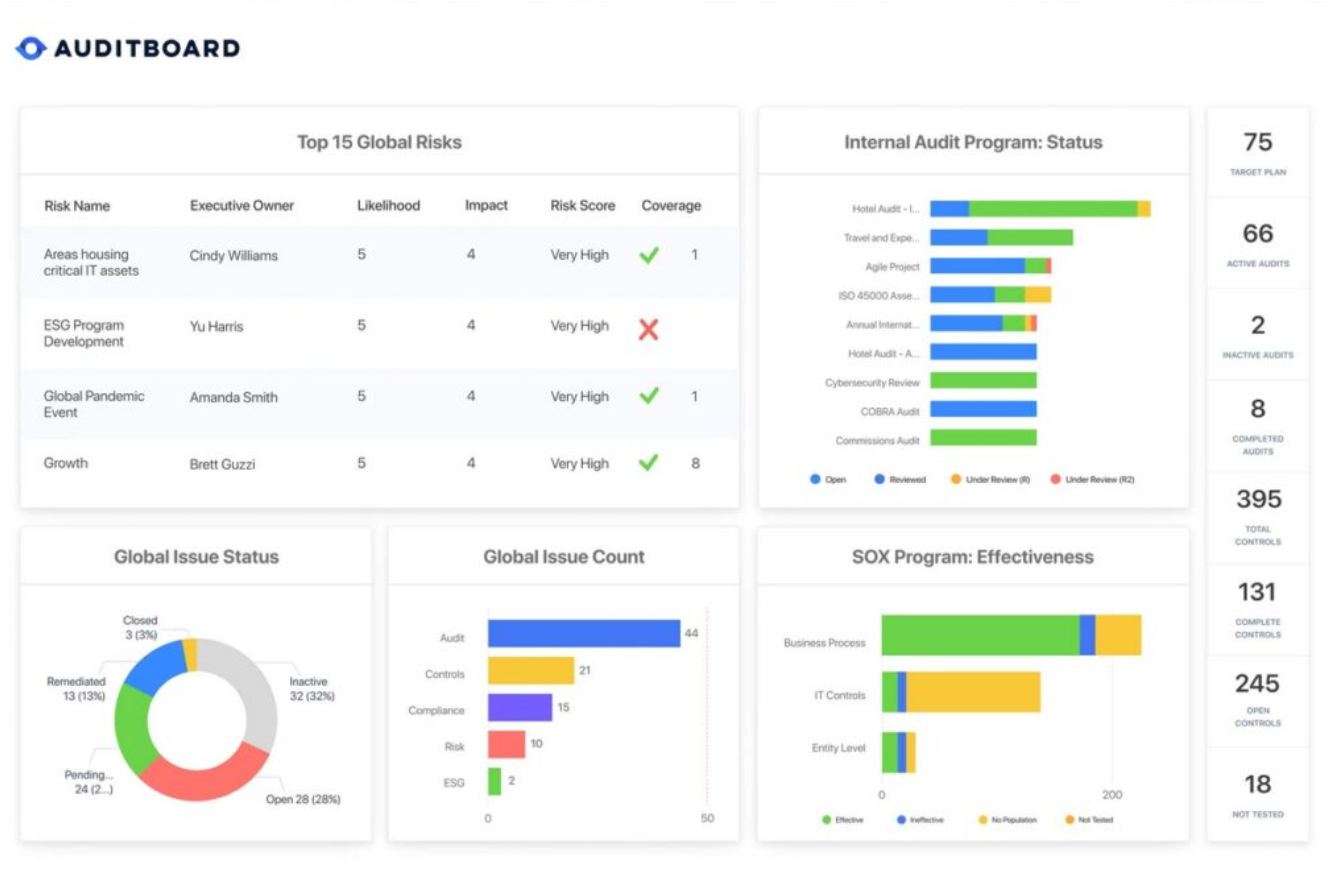
This isn't a fit for startups, but if you're preparing for IPO or managing SOX, it's the right tier.
Key Features:
- Full GRC modules: audit, risk, compliance, ESG
- AI-powered documentation and control testing
- Unlimited users
- Executive dashboards
- Deep integrations with ServiceNow, Jira
AuditBoard pricing starts at around $30,000–$ 80,000 per year, with additional implementation services ranging from $10,000 to $50,000.
Pros:
- Best for SOX and audit-heavy work
- Built for large, regulated enterprises
- Strong collaboration features
- Gartner GRC leader
Cons:
- 3–4 month setup
- Not built for fast compliance
- Overkill for SaaS under 500 people
Best For: Enterprises with full audit teams and SOX requirements. Not a Drata alternative, but it's a different product tier. Use it if you're post-Series D or public.
Read: Auditboard Review 2025 - Features, Pricing, Frameworks
8. Delve
Delve combines compliance workflows with security monitoring. It tracks vulnerabilities and risk while helping you manage audits.

This is ideal for teams that want to integrate compliance with DevSecOps or product security.
Key Features:
- Frameworks: SOC 2, ISO, PCI
- Continuous monitoring and issue alerts
- Control testing
- Built-in policy centre
- DevSecOps tool integrations
Delve pricing starts around $12,000–$30,000/year, depending on scope.
Pros:
- Covers both compliance and security
- Helps with risk management
- Strong monitoring tools
- Developer-friendly
Cons:
- Not focused on audit prep
- Complex UI
- Limited advisory support
Best for: Teams that already have SOC 2 and want to implement security automation next. Not a Drata alternative for beginners. Strong if you want to move from checklists to real security.
Read: Delve Review 2025: Pricing, Features, Reviews, FAQs
There are cases where Drata still works well. If you're a mid-sized SaaS company with SOC 2 and ISO already in place, Drata offers reliable tools for keeping audits on track.
Its automation is strong. And some auditors prefer its workflows. If you've already sunk time into setup, it might make sense to stay.
But know where it struggles:
- Support for small teams
- Transparent pricing
- Managing fast pivots or new frameworks
If you're sticking with Drata, run annual pricing checks and compare your contract to new options.
Full table comparing all 8 tools on speed, support, price, and fit for startups vs enterprise:
Next, we'll help you determine which of these tools best suits your company. We'll break it down by stage, budget, and what kind of support you'll actually need.
Which Platform is Right for You?
Choosing the right Drata alternative feels easier when you take a step back. Your company stage, team size, and budget shape the best path. Your goals may shift across quarters, so the tool must fit your real constraints.
We've seen founders choose tools that looked great on paper but slowed them later. A clear framework prevents that. This section walks you through the factors that matter most.
Company Stage
Your stage sets the tone for your compliance journey. Early teams focus on speed and clarity. Growth teams focus on scale. Enterprise teams focus on structure.
If you run a small team, heavy platforms hurt progress. ComplyJet or Sprinto work best for teams of 50 people or fewer because they move quickly and keep the process simple.
Growth stage teams deal with more frameworks. This is where Vanta, Secureframe, or Thoropass become useful because they offer more automation and broader coverage.
Enterprise teams are concerned with risk, audits, and reporting. AuditBoard fits well here. It handles SOX and large compliance programs without breaking workflows.
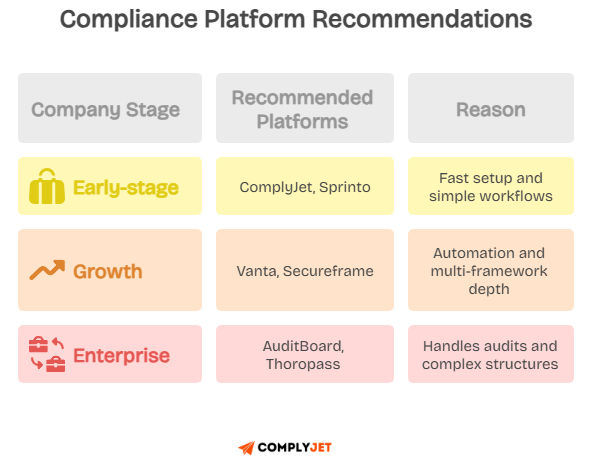
Budget
Your budget influences fit as much as features. Tools under $10K are rare in this space.
ComplyJet leads in this tier with flat pricing and no add-ons, offering a cost of $ 4,999 per year, along with one-click migration from other platforms.
For teams in the $10,000 to $25,000 range, Sprinto or Secureframe often sit in the sweet spot. You gain access to more frameworks and robust automation without the need for enterprise pricing.
Above $25K, you enter Vanta or Thoropass territory. These platforms carry more automation and deeper controls. But they also add long-term costs as you scale.
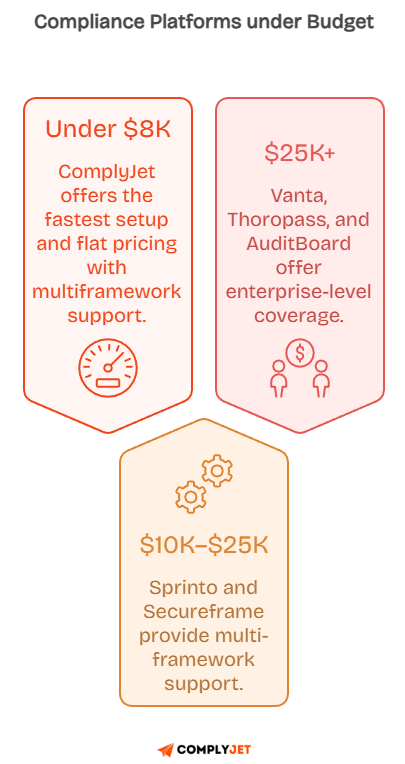
Internal Expertise
Your internal skills shape your platform choice. If you have no security or compliance hires, tools with strong guidance help you move forward more efficiently.
ComplyJet provides you with Slack access to experts, helping you complete audits with hands-on guidance. Sprinto pairs you with a success manager.
Teams with experienced engineers can utilize tools like Vanta or Secureframe with minimal friction. These provide more control but require specialized setup knowledge.
Speed Required
Your timeline may be the final deciding factor. Some teams need to achieve SOC 2 compliance by the end of this quarter. Others are planning for next year.
ComplyJet is the fastest at 7 days. Sprinto follows with 1–2 weeks. Vanta and Secureframe take longer but give more automation.
AuditBoard works for longer timelines tied to enterprise audits.
This framework helps you narrow your choices. Next, you will see how real teams saved time and money by switching from Drata to alternatives that better fit their stage.
ROI and Cost-Saving Scenarios
Compliance is an investment. The right platform helps you close deals faster and avoid painful rework. Using the wrong platform can slow your team and drain your budget.
Startup Replacing Drata
A 20-person SaaS startup moved from Drata to ComplyJet. They needed SOC 2 within weeks to unblock a contract. Drata setup took too long, and add-ons pushed the price up.
ComplyJet got them audit-ready in 7 days and cut their yearly bill by more than $10K. Their board gained confidence because the team consistently met deadlines without stress.
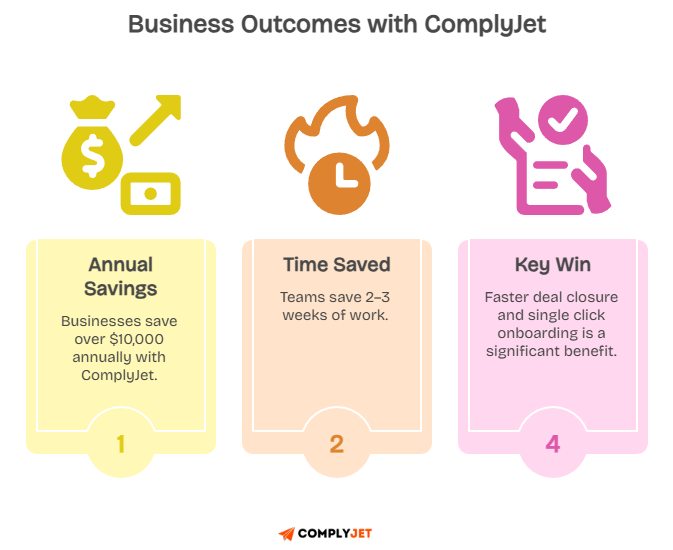
Mid-Market SaaS Migrating from Drata
A 150-person company required compliance with SOC 2 and ISO 27001. Drata became too expensive as they added frameworks. They switched to ComplyJet for control reuse and expert support.
They saved more than 60 per cent in total spend. Their audit cycles were also shortened because the team did the groundwork with them.
Learn how ComplyJet does it: Book a Demo to talk to our founders directly!
These stories demonstrate the importance of physical fitness. The next section will turn these lessons into direct answers to the most common switching questions founders ask.
Frequently Asked Questions
Can I migrate from Drata to another platform?
You can transition from Drata with minimal friction. Most platforms handle migrations for you. They help you map controls, move evidence, and rebuild your readiness phase.
Teams that switched to tools like ComplyJet or Sprinto finished migration within two to four weeks. The shift feels smoother if you move outside an active audit cycle.

What is the fastest path to SOC 2 compliance in 2025?
Speed matters when sales or funding depend on it. ComplyJet gives the fastest SOC 2 path with a seven-day readiness window for most teams.
Sprinto comes next with timelines of one to two weeks. Vanta and Secureframe take longer due to their more extensive setup steps and deeper configuration work.

Which platform offers the best support?
Support quality varies more than most founders expect. ComplyJet and Sprinto lead because you talk to real experts and not ticket systems.
Teams get Slack channels, direct access, and clear steps. These help you navigate audits and renewals with less confusion.
Who offers the most transparent pricing?
ComplyJet offers the cleanest pricing today. You see the full number upfront, with no surprises for per-framework or per-user costs.
Sprinto comes close, but you still pay extra for each framework. Vanta, Drata, and Secureframe have hidden fees tied to add-ons and renewals.

Is switching from Drata during audit cycles a risky move?
Switching during an audit cycle is possible, but it can be a stressful process. Your new platform must rebuild your audit trail.
Most founders wait until the report is done. When you switch between cycles, the move feels easier and avoids missing evidence.
How much money can I save by switching to a new plan?
Savings depend on frameworks, team size, and contracts. Many founders save more than $ 10,000 each year when they switch from Drata to ComplyJet.
ComplyJet also gives mid-market teams up to 60 percent savings when using two or more frameworks. Enterprise shifts usually save less but gain stronger controls.
Conclusion
Drata is still a strong tool, but it is no longer the only path to compliance.
Today's market gives you more speed, better support, and clearer pricing when you choose the right fit.
You can save thousands each year by choosing a platform that aligns with your stage. You may also move faster, close deals sooner, and avoid complex workflows that slow your team.
For clarity, consider starting with a free trial on ComplyJet or conducting a small pilot alongside Drata. This side-by-side test shows real numbers without guesswork.
Start your compliance journey without the Drata drag. Book a demo with ComplyJet today!



